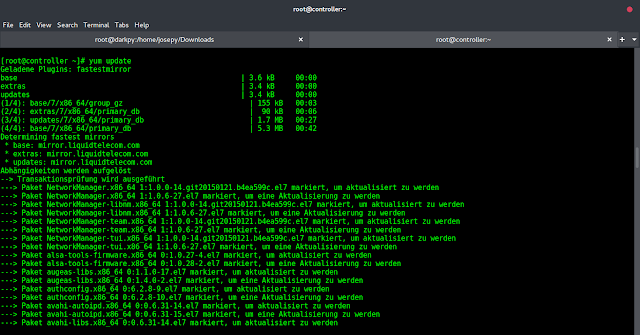A character in UTF-8 can be from 1 to 4 bytes long, subjected to the following rules:
- For a 1-byte character, the first bit is a 0, followed by its Unicode code.
- For n-bytes character, the first n-bits are all ones, the n+1 bit is 0, followed by n-1 bytes with the most significant 2 bits being 10.
This is how the UTF-8 encoding would work:
Char. number range | UTF-8 octet sequence
(hexadecimal) | (binary)
--------------------+---------------------------------------------
0000 0000-0000 007F | 0xxxxxxx
0000 0080-0000 07FF | 110xxxxx 10xxxxxx
0000 0800-0000 FFFF | 1110xxxx 10xxxxxx 10xxxxxx
0001 0000-0010 FFFF | 11110xxx 10xxxxxx 10xxxxxx 10xxxxxx
Example:
Given an array of integers representing the data, return whether it is a valid UTF-8 encoding.
The input is an array of integers. Only the least significant 8 bits of each integer is used to store the data. This means each integer represents only 1 byte of data.
data = [235, 140, 4], which represented the octet sequence: 11101011 10001100 00000100.
Return false.
The first 3 bits are all one’s and the 4th bit is 0 means it is a 3-bytes character.
The next byte is a continuation byte which starts with 10 and that’s correct.
But the second continuation byte does not start with 10, so it is invalid.
———————————————————————————————–
data = [197, 130, 1], which represents the octet sequence: 11000101 10000010 00000001.
Return true.
It is a valid utf-8 encoding for a 2-bytes character followed by a 1-byte character.
Approach 1: As long as every byte in the array is of the right type, it is a valid UTF-8 encoding.
- Start from index 0, determine each byte’s type and check its validity.
- There are five kinds of valid byte type: 0**, 10**, 110**,1110** and 11110**
- Give them type numbers, 0, 1, 2, 3, 4 which are the index of the first 0 from left.
- So, the index of the first 0 determines the byte type.
- If a byte belongs to one of them: if it is type 0, continue if it is type 2 or 3 or 4, check whether the following 1, 2, and 3 byte(s) are of type 1 or not.
- If not, return false; else if a byte is type 1 or not of valid type, return false.
Java
// Java program to check whether the data// is a valid UTF-8 encodingimport java.io.*;import java.util.*;class Sol { private int[] masks = { 128, 64, 32, 16, 8 }; public boolean validUtf8(int[] data) { int len = data.length; // for each value in the data array we have to take // the "and" with the masks array for (int i = 0; i < len; i++) { int curr = data[i]; // method to check the array if the // and with the num and masks array is // 0 then return true int type = getType(curr); if (type == 0) { continue; } else if (type > 1 && i + type <= len) { while (type-- > 1) { if (getType(data[++i]) != 1) { return false; } } } else { return false; } } return true; } // method to check the type public int getType(int num) { for (int i = 0; i < 5; i++) { // checking the each input if ((masks[i] & num) == 0) { return i; } } return -1; }}class GFG { public static void main(String[] args) { Sol st = new Sol(); int[] arr = { 197, 130, 1 }; boolean res = st.validUtf8(arr); System.out.println(res); }} |
true
Time Complexity: O(n)
Auxiliary Space: O(1)
Approach 2: To translate the provided data array into a sequence of valid UTF-8 encoded characters
- Start with count = 0.
- for “i” ranging from 0 to the size of the data array.
- Take the value from data array and store it in x = data[i]
- If the count is 0, then
- If x/32 = 110, then set count as 1. (x/32 is same as doing x >> 5 as 2^5 = 32)
- Else if x/16 = 1110, then count = 2 (x/16 is same as doing x >> 4 as 2^4 = 16)
- Else If x/8 = 11110, then count = 3. (x/8 is same as doing x >> 3 as 2^3 = 8)
- Else if x/128 is 0, then return false. (x/128 is same as doing x >> 7 as 2^7 = 128)
- Else If x/64 is not 10, then return false and decrease the count by 1.
3. When the count is 0, return true.
Java
// Java program to check whether the data// is a valid UTF-8 encodingimport java.io.*;import java.util.*;class Sol { public boolean validUtf8(int[] data) { int count = 0; for (int i = 0; i < data.length; i++) { int x = data[i]; if (count == 0) { if ((x >> 5) == 0b110) count = 1; else if ((x >> 4) == 0b1110) count = 2; else if ((x >> 3) == 0b11110) count = 3; else if ((x >> 7) != 0) return false; } else { if ((x >> 6) != 0b10) return false; count--; } } return (count == 0); }}class GFG { public static void main(String[] args) { Sol st = new Sol(); int[] arr = { 197, 130, 1 }; boolean res = st.validUtf8(arr); System.out.println(res); }} |
true
Time Complexity: O(N)
Auxiliary Space: O(1)




